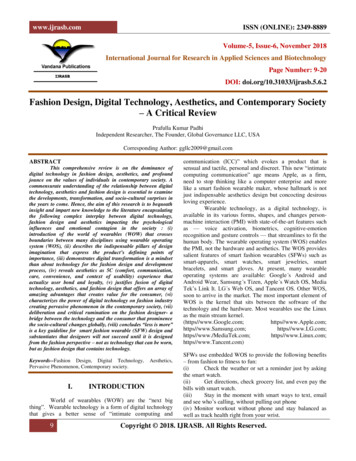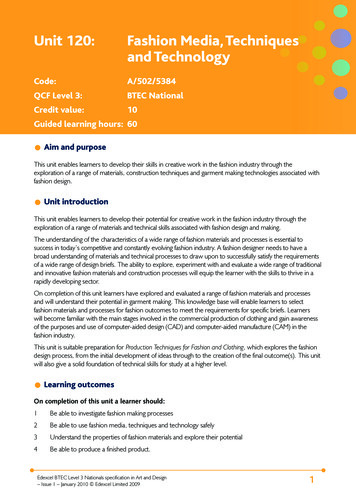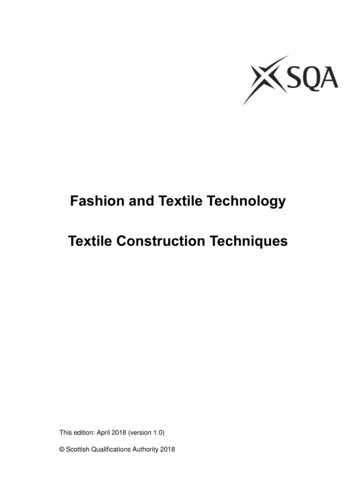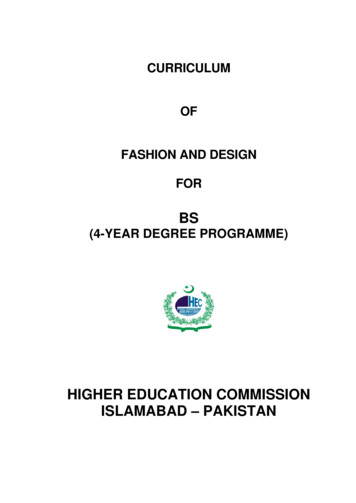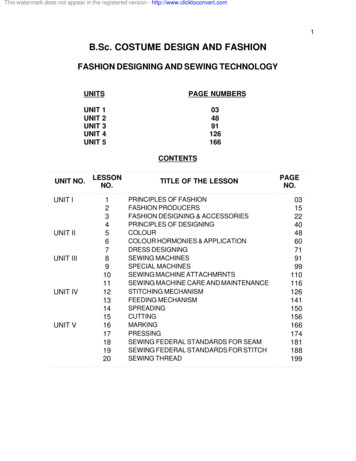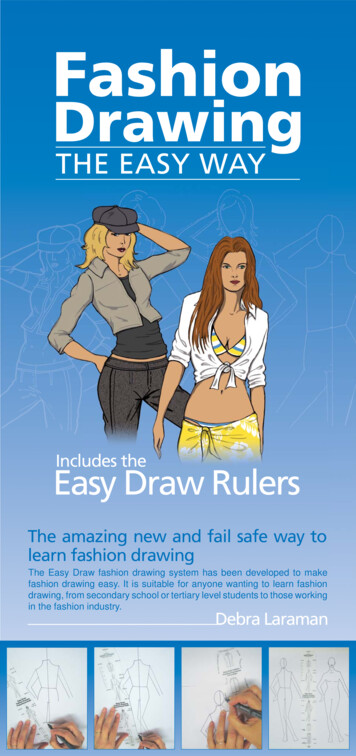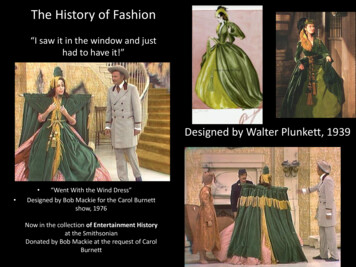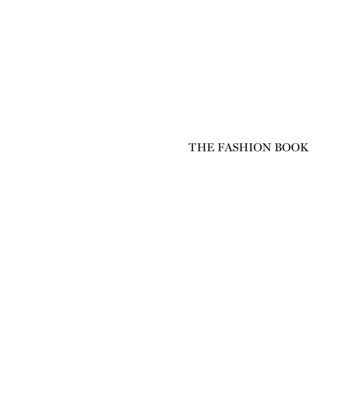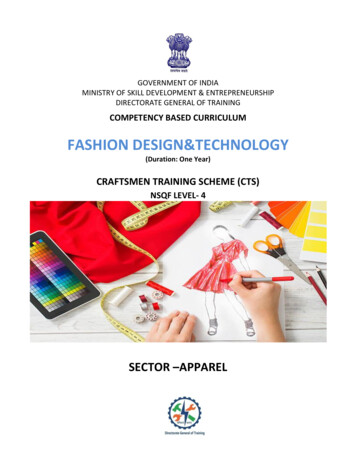
Transcription
GOVERNMENT OF INDIAMINISTRY OF SKILL DEVELOPMENT & ENTREPRENEURSHIPDIRECTORATE GENERAL OF TRAININGCOMPETENCY BASED CURRICULUMFASHION DESIGN&TECHNOLOGY(Duration: One Year)CRAFTSMEN TRAINING SCHEME (CTS)NSQF LEVEL- 4SECTOR –APPAREL
FASHIONDESIGN&TECHNOLOGY(Non-Engineering Trade)(Revised in 2019)Version: 1.2CRAFTSMEN TRAINING SCHEME (CTS)NSQF LEVEL - 4Developed ByMinistry of Skill Development and EntrepreneurshipDirectorate General of TrainingCENTRAL STAFF TRAINING AND RESEARCH INSTITUTEEN-81, Sector-V, Salt Lake City,Kolkata – 700 091www.cstaricalcutta.gov.in
CONTENTSSNo.TopicsPage No.1.Course Information12.Training System23.Job Role64.General Information75.Learning Outcome96.Assessment Criteria107.Trade Syllabus13Annexure I(List of Trade Tools & Equipment)23Annexure II (List of Trade experts)27
Fashion Design & Technology1. COURSE INFORMATIONDuring the one-year duration of “Fashion Design & Technology” trade a candidate istrained on Professional Skill, Professional Knowledge and Employability Skill related to job role. Inthis trade we encourage each and every student to access and nurture their own natural sense offlair and creativity. We also help them to know that how can they create new ideas, thoughts andalso to execute them in real form. In addition to this a candidate is entrusted to undertake projectwork, extracurricular activities and on job training to build up confidence. The broad componentscovered under Professional Skill subject are as below:The broad professional skills covered as part of the skill training start with familiarizationand identification of tools & sewing machine, sketches of female croquie and design usingelements and principle of design in terms of dress. The trainees learn to draw texture and performfabric rendering. Also develop motifs for various traditional embroideries and perform machinestitches to make different parts as per design. The content also covers different fabrics; designingthrough Corel draw and working on special effects are also part of the professional components inthis part. The professional skill starts sketching different elements of garment. Develop differentviews of male & female croquie and develop designer wears based on draping techniques. Ensuresquality and gets ideas about fashion merchandising and career prospect in the field. Finally, thetrainees imparts skill on designing fashion accessories as per latest trend.The trainee also undergoes two weeks project work at the mid and end of the year whichgives them more practical exposure and helps to build up confidence level.1
Fashion Design & Technology2. TRAINING SYSTEM2.1 GENERALThe Directorate General of Training (DGT) under Ministry of Skill Development &Entrepreneurship offers a range of vocational training courses catering to the need of differentsectors of economy/ Labour market. The vocational training programmes are delivered under theaegis of Directorate General of Training (DGT). Craftsman Training Scheme (CTS) with variants andApprenticeship Training Scheme (ATS) are two pioneer schemes of DGT for strengtheningvocational training.Fashion Design & Technology trade under CTS is one of the popular coursesdeliverednationwide through a network of ITIs. The course is of one-year duration. It mainly consists ofDomain area and Core area. The Domain area (Trade Theory & Practical) imparts professional skillsand knowledge, while the core area (Employability Skill) imparts requisite core skills, knowledge,and life skills. After passing out the training program, the trainee is awarded National TradeCertificate (NTC) by DGT which is recognized worldwide.Broadly candidates need to demonstrate that they are able to: Read & interpret parameters/documentation, plan work, identify necessary materials andtools;Perform task with due consideration to safety rules, accident prevention regulations andenvironmental protection stipulations;Apply professional knowledge, core skills & employability skills while performing the job.Check the task/assembly as per drawing for functioning, identify and rectify errors in task.Document the parameters related to the task undertaken.2.2 PROGRESSION PATHWAYS: Can join industry as Craftsman and will progress further as Senior Craftsman, Supervisorand can rise up to the level of Manager.Can become Entrepreneur in the related field.Can join Apprenticeship programme in different types of industries leading to NationalApprenticeship certificate (NAC).Can join Crafts Instructor Training Scheme (CITS) in the trade for becoming instructor inITIs.Can join advanced Diploma (Vocational) courses under DGT as applicable.2
Fashion Design & Technology2.3 COURSE STRUCTURE:Table below depicts the distribution of training hours across various course elementsduring a period of one-year: S No.1.2.3.Course ElementProfessional Skill (Trade Practical)Professional Knowledge (Trade Theory)Employability SkillsTotalNotional TrainingHours120024016016002.4 ASSESSMENT & CERTIFICATIONThe trainee will be tested for his skill, knowledge and attitude during the period of coursethrough formative assessment and at the end of the training programme through summativeassessment as notified by the DGTfrom time to time.a) The Continuous Assessment (Internal)during the period of training will be done by FormativeAssessment Method by testing for assessment criteria listed against learning outcomes. Thetraining institute has to maintain an individual trainee portfolio as detailed in assessmentguideline. The marks of internal assessment will be as per the formative assessment templateprovided on www.bharatskills.gov.inb) The final assessment will be in the form of summative assessment. The All India Trade Test forawarding NTC will be conducted by Controller of examinations, DGT as per the guidelines. Thepattern and marking structure is being notified by DGT from time to time. The learning outcomeand assessment criteria will be the basis for setting question papers for final assessment. Theexaminer during final examination will also check the individual trainee’s profile as detailed inassessment guideline before giving marks for practical examination.2.4.1 PASS REGULATIONFor the purposes of determining the overall result, weightage of 100% is applied for sixmonths and one year duration courses and 50% weightage is applied to each examination for twoyears courses. The minimum pass percent for Trade Practical and Formative assessment is 60% &for all other subjects is 33%. There will be no Grace marks.3
Fashion Design & Technology2.4.2 ASSESSMENT GUIDELINEAppropriate arrangements should be made to ensure that there will be no artificial barriersto assessment. The nature of special needs should be taken into account while undertaking theassessment. Due consideration should be given while assessing for teamwork,avoidance/reduction of scrap/wastage and disposal of scrap/waste as per procedure, behavioralattitude, sensitivity to the environment and regularity in training. The sensitivity towards OSHEand self-learning attitude are to be considered while assessing competency.Assessment will be evidence based comprising the following: Job carried out in labs/workshopRecord book/ daily diaryAnswer sheet of assessmentViva-voceProgress chartAttendance and punctualityAssignmentProject workEvidences and records of internal (Formative) assessments are to be preserved untilforthcoming examination for audit and verification by examining body. The following markingpattern to be adopted while assessing:Performance LevelEvidence(a) Weightage in the range of 60%-75% to be allotted during assessmentFor performance in this grade, the candidateshould produce work which demonstratesattainment of an acceptable standard ofcraftsmanship with occasional guidance, anddue regard for safety procedures and practices Demonstration of good skills andaccuracy in the field of work/assignments. A fairly good level of neatness andconsistency to accomplish job activities. Occasional support in completing thetask/ job.(b) Weightage in the range of 75%-90% to be allotted during assessmentFor this grade, a candidate should producework which demonstrates attainment of a4 Good skill levels and accuracy in thefield of work/ assignments.
Fashion Design & Technology A good level of neatness andconsistency to accomplish job activities. Little support in completing thetask/job.(c) Weightage in the range of more than 90% to be allotted during assessmentreasonable standard of craftsmanship, withlittle guidance, and regard for safetyprocedures and practicesFor performance in this grade, the candidate,with minimal or no support in organization andexecution and with due regard for safetyprocedures and practices, has produced workwhich demonstrates attainment of a highstandard of craftsmanship.5 High skill levels and accuracy in the fieldof work/ assignments. A high level of neatness and consistencyto accomplish job activities. Minimal or no support in completingthe task/ job.
Fashion Design & Technology3. JOB ROLEDesigner; Pattern Maker (Garments) develops, designs and makes pattern for new styles ofmen's, women's and children's garments. Studies existing styles, develops new ideas and drawsout full scale drawing of garments on paper. Marks and cuts out paper patterns of different partsof garments. Gets cloth cut according to paper patterns and gets sample garment stitched asrequired. Tries garment on model and makes changes in pattern, if necessary. May makespecifications and supervise production.Reference NCO-2015:(i) 7532.0100 - Designer; Pattern Maker6
Fashion Design & Technology4. GENERAL INFORMATIONName of the TradeFASHION DESIGN & TECHNOLOGYTrade CodeDGT/1026NCO - 20157532.0100NSQF LevelLevel – 4Duration of Craftsmen TrainingOne year (1600 Hours)Minimum Age14 years as on first day of academic session.Entry QualificationPassed 10th class examinationEligibility for PwDLD,CP,LC,DW,AA,LV,DEAF,HH,AUTISM,ID,SLDUnit Strength (No. of Student)20(There is no separate provision of supernumerary seats)Space Norms64 sq. mPower Norms5 KWInstructors Qualification for(i)FashionDesignTechnology Trade& B.Voc./Degree (4 yrs duration) in fashion Designing/Technology from UGC Recognized university with one yearExperience in the relevant fieldORB.Voc./Degree (3 yrs duration) in fashion Designing/Technology from UGC Recognized university with two yearExperience in the relevant fieldORThree year Diploma in fashion Designing/ Technology/ CDDMfrom recognized board of education or relevantAdvancedDiploma (Vocational) from DGT with Two Years’ Experience.ORNTC/NAC passed in Fashion design & technology (earliername of trade as "Fashion Technology” with three years’experience in the relevant field.Essential Qualification:Relevant National Craft Instructor Certificate (NCIC) in any ofthe variants under DGT.Note: Out of two Instructors required for the unit of 2(1 1),one must have Degree/Diploma and other must have7
Fashion Design & Technology(ii) Employability Skill(iii) MinimumageInstructorList of Tools and EquipmentNTC/NAC qualifications. However both of them mustpossess NCIC in any of its variants.MBA/ BBA / Any Graduate/ Diploma in any discipline withTwo years’ experience with short term ToT Course inEmployability Skills from DGT institutes.(Must have studied English/ Communication Skills and BasicComputer at 12th / Diploma level and above)ORExisting Social Studies Instructors in it is withshort term ToTCourse in Employability Skills from DGT institutes.for 21 yearsAs per Annexure – IDistribution of training on Hourly basis: (Indicative only)Total Hrs /weekTrade PracticalTrade TheoryEmployability Skills40 Hours30 Hours6 Hours4 Hours8
Fashion Design & Technology5. LEARNING OUTCOMELearning outcomes are a reflection of total competencies of a trainee and assessment will becarried out as per the assessment criteria.5.1LEARNING OUTCOMES (TRADE SPECIFIC)1. Interpret and illustrate importance of Fashion designing following safety precautions.2. Sketch fashion croquie of female and design garments with the help of elements usingprinciples of design and colour scheme.3. Drape, illustrate Fabric rendering and drawing texture.4. Apply surface ornamentation with embroidery.5. Apply basic Stitches, Seams and Edge finishes with operation on Sewing machine.6. Identify different Fibres and Fabrics along with Weaves and Knits.7. Create and Design Garments and Accessories in Corel Draw using tools and commands.8. Create Bodice Block Set & Patterns and construct samples of Design Details.9. Apply garment details in fashion illustration.10. Illustrate Male and Female wear on Croquie and develop designer Wears based on drapingTechnique/ sketches as per fashion & style.11. Analyse human anatomy with Eight Head theory and different types of body contour.12. Ensure the Quality of production.13. Analyse fashion merchandising, fashion scope and Career Prospect.14. Create and Design Fashion accessories as per latest trend.9
Fashion Design & Technology6. ASSESSMENT CRITERIALEARNING OUTCOMESASSESSMENT CRITERIA1. Interpretandillustrateimportance of Fashion designingfollowing safety precautions.Appraise the importance of Fashion Designing in socioeconomic point of view.Identify the requirement of designing to modernize andalso link it with our past eras with change of habit and use.Compare and relate Fashion Designing with otherindustries.Functional and operational knowledge of tools equipmentsand drawing materials and its operations.2. Sketch fashion croquie of femaleand design garments with thehelp of elements using principlesof design and colour scheme.Create a fashion Stick and Block Figure (10.5 & 12.5 heads).Drape the designer wear on Female Croquie and showOptical illusions.Recognize the elements and principle of designing in FashionDesigning.Recognize and apply colour sets (Warm & Cool) in designing.Draw Geometrical, Abstract and Realistic shapes & forms.Apply
Fashion Design & Technology trade under CTS is one of the popular coursesdelivered nationwide through a network of ITIs. The course is of one-year duration. It mainly consists of Domain area and Core area. The Domain area (Trade Theory & Practical) imparts professional skills and knowledge, while the core area (Employability Skill) imparts requisite core skills, knowledge, and life skills .


